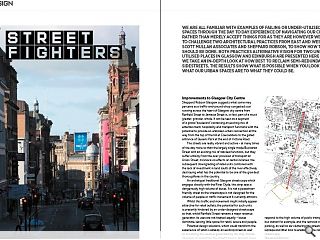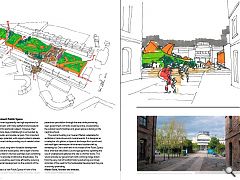Re:Design: Glasgow & Edinburgh
30 Oct 2012
We are all familiar with examples of failing or under-utilised public spaces through the day to day experience of navigating our cities. Rather than merely accept things for as they are however we elected to challenge two architectural practices from east and west, Smith Scott Mullan associates and Sheppard Robson, to show how things should be done. Both practices alternative vision for two under-utilised places in Glasgow and Edinburgh are presented here before we take an in-depth look at how best to reclaim semi-redundant sidestreets. The results show what is possible when you look beyond what our urban spaces are to what they could be.
Improvements to Glasgow City CentreSheppard Robson Glasgow suggests what some may perceive as a traffic-and-pound-shop congested scar running across the heart of Glasgow city centre from Renfield Street to Jamaica Street is, in fact, part of a much greater, grander, whole. It can be seen as a segment of a grand ‘boulevard’ containing an exciting mix of entertainment, hospitality and transport functions with the potential to provide an unbroken urban connection all the way from the top of the hill at Cowcaddens to the gated entrance of Queens Park at the end of Victoria Road.
The streets are really vibrant and active – at many times of the day more so than the largely single mode Buchanan Street with an exciting mix of stacked functions, but they suffer unfairly from the over-provision of transport at Union Street; its knock-on effects on rental incomes; the subsequent downgrading of retail units combined with the lack of investment in land south of the river effectively destroying what has the potential to be one of the grandest thoroughfares in the country.
An archetypal traditional Glasgow streetscape which engages directly with the River Clyde, this strip sees a dangerously high volume of buses. It is not a pedestrian-friendly street as the streetscape is not designed for the volume of people or traffic movement it currently attracts.
Whilst this traffic and movement might initially appear attractive for retail outlets, the potential for such units is presently hindered by an under-designed streetscape so that, whilst Renfield Street remains a major revenue generator, its uses are not treated equally – buses dominate, leaving little space for retail, leisure and people.
Potential design solutions, which could transform the experience of what is already an exciting street as well as increasing the revenue generated by the strip include designing or amending the streetscape to; respond more appropriately to people volume and night-time functions, respond to the high volume of public transport – a linear bus station for example, and the removal of public car parking, as well as de-cluttering the streets of random signage and litter bins to enable a more cohesive, shared streetscape.
Sheppard Robson,
Glasgow office
Scottish Government Public Space
The Scottish Government apparently has high aspirations for Sustainable Development, with many leaflets and procedural boxes ticked around this particular subject. However, their headquarters in Victoria Quay in Edinburgh is surrounded by a vast area of both public and private car park. This important new building has major potential, with opportunities to elevate the status of Government while providing much needed urban regeneration.
I envisage a practical, long-term fundable development containing commercial and social space, with a layer of active uses wrapping large interior volumes (perhaps even containing some of those cars) to provide an attractive streetscape. The key is that the space would be used more efficiently, reducing the need for commercial development on the outskirts of the city.
Central to the idea is a new Public Space in front of the main entrance. This could be used for events and would create pedestrian percolation through the area while promoting open government. All roofs would be active, incorporating the outdoor sports facilities and green space so lacking in the neighbourhood.
The central building is a Covered Market, adaptable for exhibitions, trade shows and musical events. It is designed as a metaphor of a glacier, a dynamic landscape form punctured with roof lights reminiscent of the erratic boulders left by retreating ice. One is even left in the middle of the Public Space, like a small but naturalistic Louvre type pyramid, signalling the use of underground galleries (the site is a former dock). This would provide our government with a striking image drawn from the very root of Scottish history and acting as a timely reminder of the need for the Sustainable Development they are so actively promoting.
Alistair Scott, founder and director,
Smith Scott Mullan Associates




